Key takeaways:
- Interfaith education fosters empathy and respect by encouraging individuals to share their stories and perspectives.
- Religious education combats stereotypes and misconceptions, promoting critical thinking and deeper relationships.
- Engaging with diverse faiths nurtures a sense of connection and shared humanity through open dialogue and personal experiences.
- Effective interfaith communication requires active listening, sharing personal stories, and creating a safe space for questions to encourage understanding and curiosity.
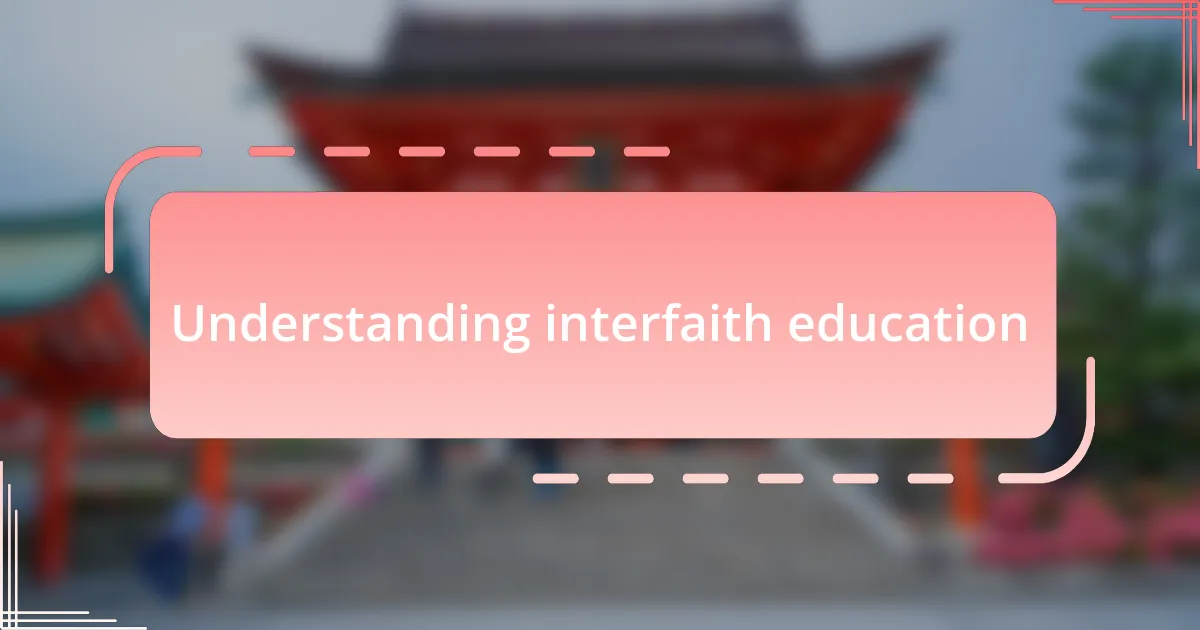
Understanding interfaith education
Interfaith education is about more than just learning about different religions; it’s an opportunity to foster empathy and respect among diverse beliefs. I remember sitting in a classroom filled with students from various faith backgrounds, each sharing their stories. That moment made me realize how powerful it is to understand someone else’s perspective—like seeing the world through a different lens.
In my experience, interfaith education helps break down the barriers that often divide us. I once attended a workshop where participants were challenged to discuss their religious beliefs openly. It was both nerve-wracking and liberating, as I discovered common values that transcended our differences, igniting my curiosity about others’ worldviews.
Ultimately, interfaith education invites us to ask ourselves: how can we build bridges in our increasingly diverse society? When I see individuals engage in respectful dialogue, it fills me with hope. These conversations are crucial, as they encourage us to appreciate the richness of our shared humanity while honoring our unique paths.
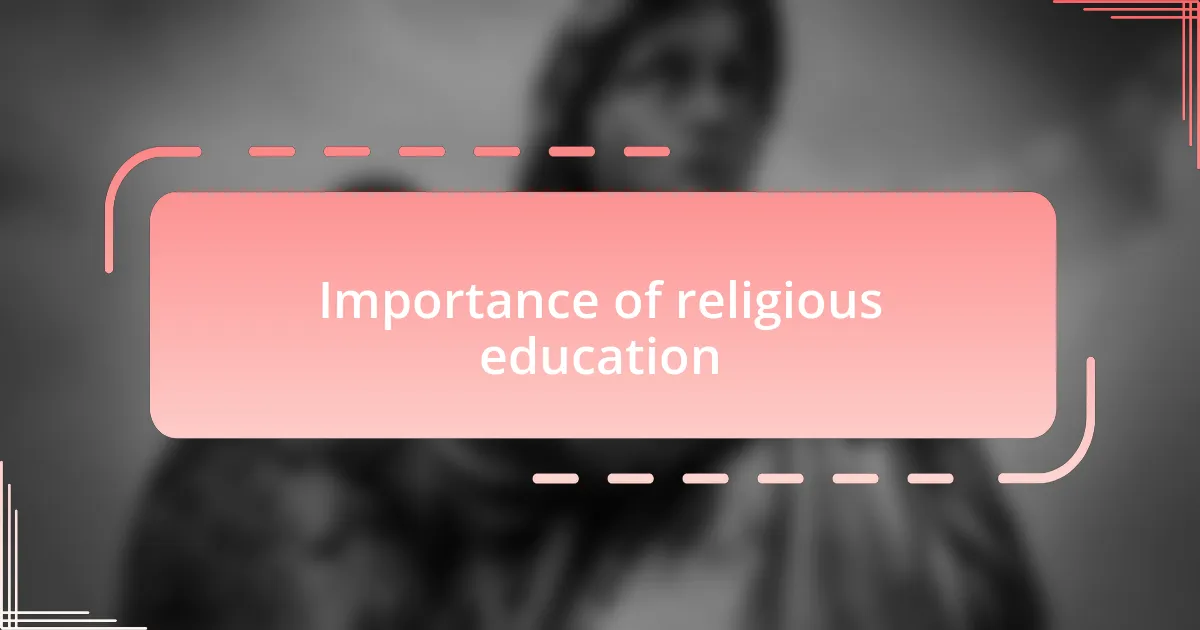
Importance of religious education
Religious education holds a vital place in fostering understanding among individuals of varying beliefs. I recall an instance when I participated in a discussion group focused on different religious traditions. As we shared personal experiences and the teachings of our respective faiths, I experienced firsthand how knowledge deepens relationships and cultivates compassion.
In my view, the importance of religious education also lies in its ability to combat stereotypes and misconceptions. During a community event, I met someone whose beliefs were vastly different from my own. Initially, I felt apprehensive, but as our conversation unfolded, I learned about their values and the reasons behind their perspectives. This exchange not only challenged my assumptions but also highlighted how ignorance can fuel division and fear.
Moreover, religious education encourages critical thinking and self-reflection. I remember a time when I was asked to examine my beliefs alongside those of others in a classroom setting. It was a thought-provoking experience, leading me to question my perspectives while gaining insights into others’ faiths. Isn’t that what education is all about—growing together as we explore the diverse tapestry of human experience?
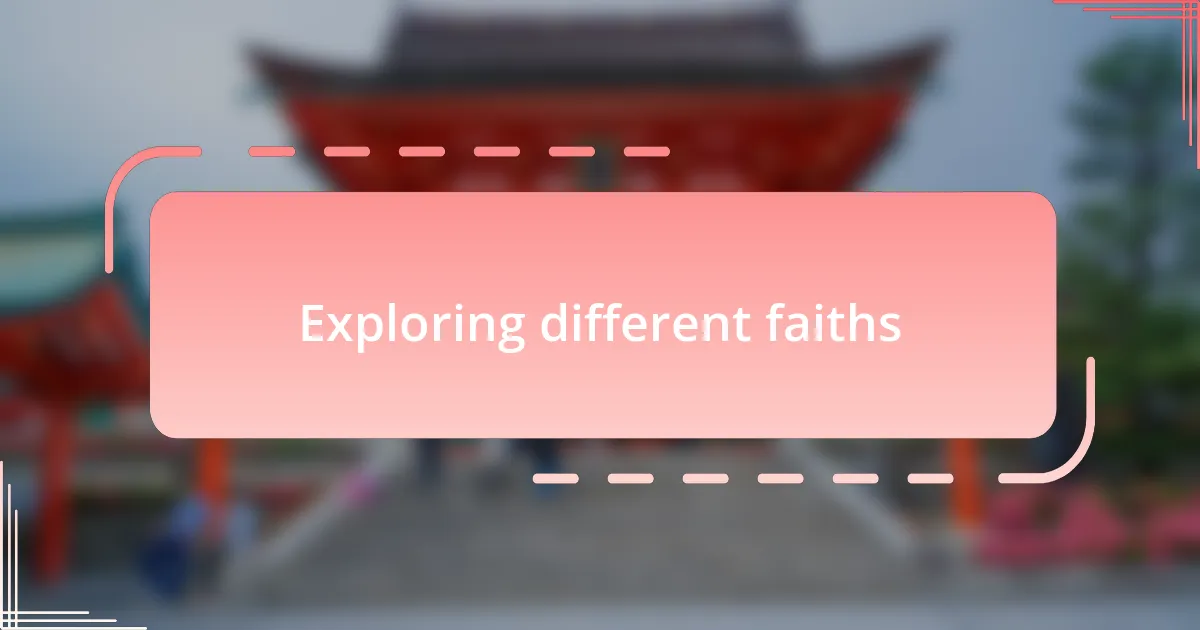
Exploring different faiths
Exploring different faiths has been a transformative journey for me. I remember attending a multi-faith festival where various religions showcased their beliefs and practices. It struck me how, despite the differences in rituals and doctrines, there was a common thread of hope, love, and community that resonated with everyone. This experience reminded me that faith is often about connection and shared humanity.
Engaging with diverse spiritual traditions has often left me feeling a mix of curiosity and awe. I once visited a local mosque during Ramadan and was welcomed with open arms. As I sat down to break bread with my hosts, I felt an overwhelming sense of belonging, even amidst my unfamiliarity. Isn’t it remarkable how food can bridge divides? This experience deepened my appreciation for the rich cultural tapestries woven by different faiths.
As I delved deeper into various belief systems, I realized that exploring these traditions often involves grappling with complex emotions. I vividly recall reading about the principles of Buddhism and feeling a sense of calm wash over me. The idea of mindfulness resonated so deeply that it influenced my approach to daily stressors. This led me to ponder: How can we incorporate lessons from one faith into our own lives? Each exploration enriches not just our knowledge but also our capacity for empathy and understanding.
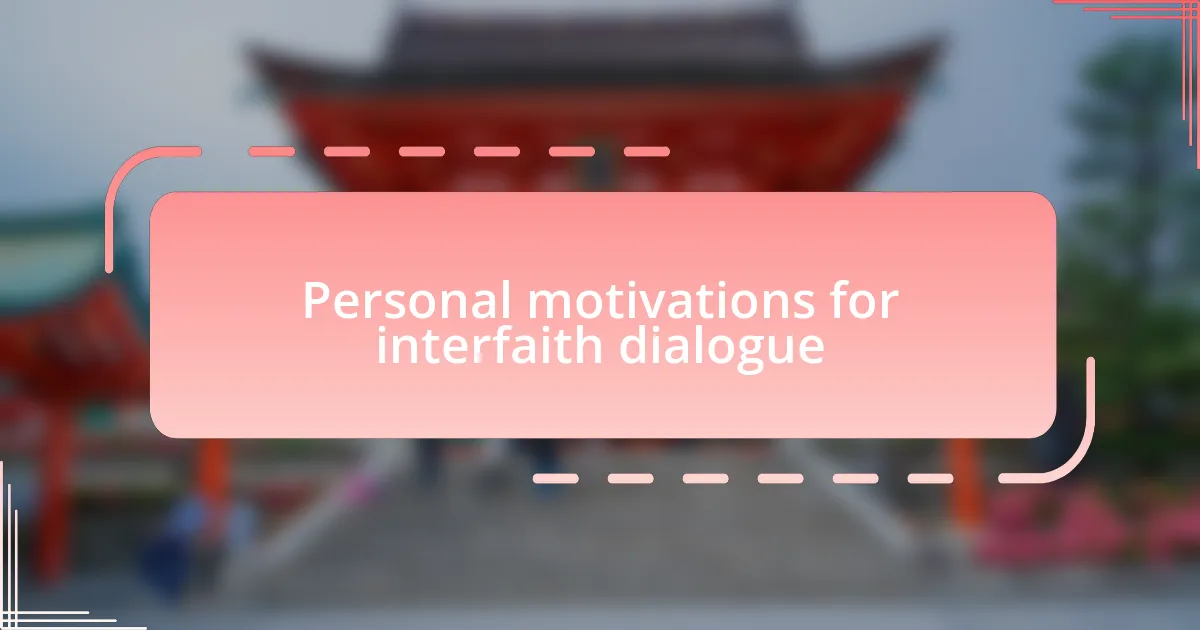
Personal motivations for interfaith dialogue
Engaging in interfaith dialogue has always been more than an academic pursuit for me; it stems from a genuine desire to understand and connect with others. I recall a time when a friend shared their struggles in balancing their faith with a personal crisis. Listening to their story inspired me to reflect on my own beliefs and how they shape my identity. Isn’t it fascinating how sharing our challenges can pave the way for deeper understanding?
One powerful motivator for me is the realization that differences can foster strength rather than division. I remember attending a discussion group where individuals from various religious backgrounds openly shared their perceptions of morality and ethics. Each perspective offered me fresh insights and challenged my own assumptions. It left me wondering: How can embracing divergent views lead us to more holistic solutions in our communities?
Furthermore, the urgency of our current global climate reinforces my motivation for interfaith discourse. I often think about the role of compassion in mitigating conflict. I was once struck by a project where faith leaders came together to address local issues like poverty and education. Their collaborative efforts showcased an essential truth: together, we can create a more just and harmonious world. How could we transform our societies if we actively sought these partnerships?
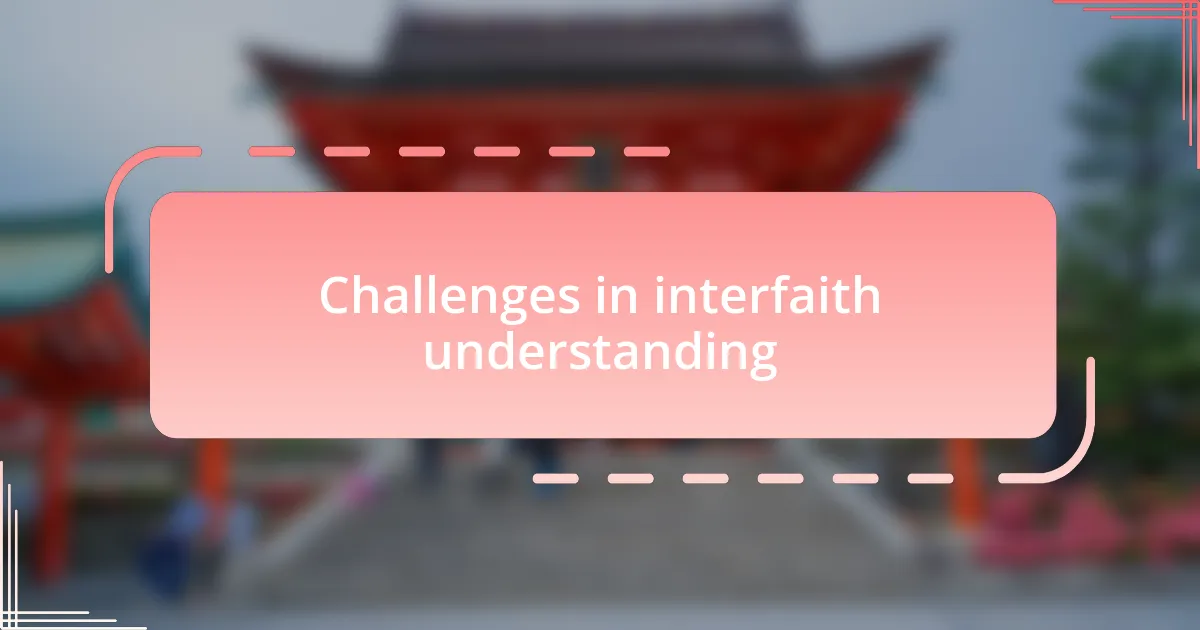
Challenges in interfaith understanding
Navigating interfaith understanding often encounters deep-rooted biases and stereotypes. I once faced this firsthand during a community meeting where assumptions about my beliefs were laid bare. The moment felt uncomfortable, but it made me realize that many people approach interfaith dialogue with preconceived notions, which can stifle genuine communication. Have you ever been in a situation where someone’s assumptions clouded their understanding of your perspective? I find that actively addressing these biases can often be the first step toward building bridges.
Another challenge I’ve encountered is the emotional intensity surrounding personal beliefs. I vividly remember a discussion that escalated when someone felt their faith was being critiqued. It was a poignant reminder of how deeply our beliefs can shape our identities and perspectives. How can we communicate respectfully without triggering defensiveness? I’ve learned that patience and empathy are vital, creating a space where everyone feels heard and valued, even when emotions run high.
Finally, the varying levels of commitment to dialogue can be disheartening. During a workshop I attended, some participants were eager to engage, while others seemed indifferent to the process. This discrepancy serves as a barrier to meaningful dialogue. I often ask myself: how can we foster an environment where everyone is genuinely invested in the conversation? It’s clear to me that encouraging openness and commitment from all parties can create a fertile ground for understanding, allowing diverse voices to come together meaningfully.
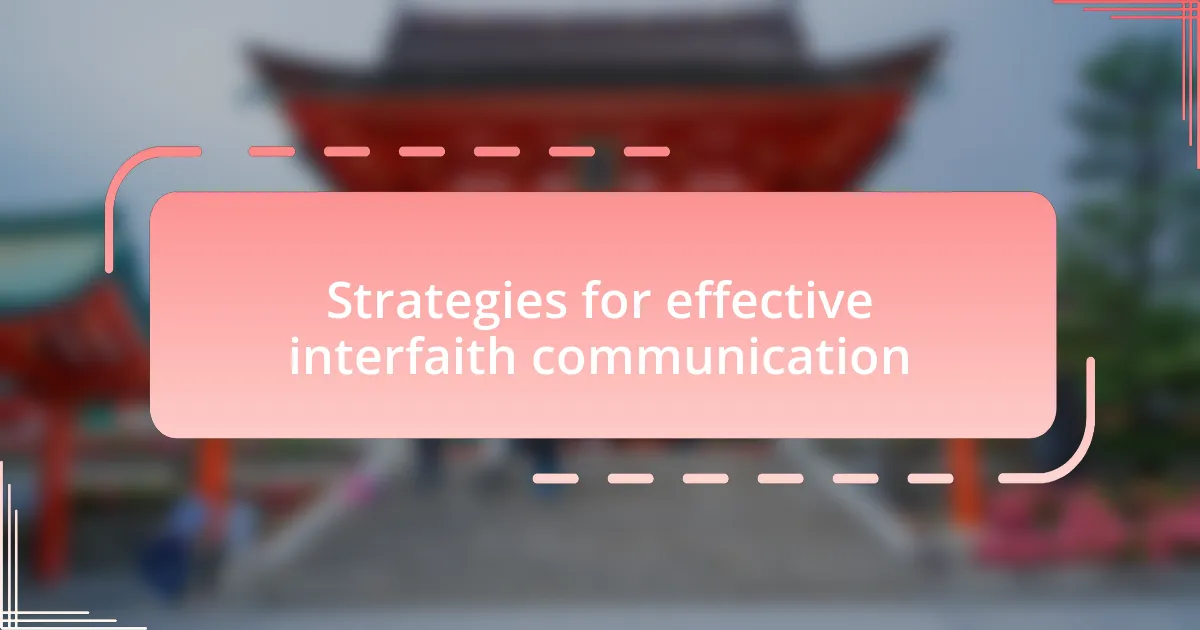
Strategies for effective interfaith communication
One effective strategy for interfaith communication is to focus on active listening. I recall a dialogue session where I encouraged participants to summarize what others shared before responding. This small change transformed the atmosphere. Suddenly, people felt genuinely acknowledged, which allowed for a deeper exploration of beliefs. Have you ever noticed how simply being heard can dissolve tension?
Another approach that has served me well is sharing personal stories rather than just doctrinal points. I remember sharing a defining moment in my faith that resonated with others, sparking their willingness to open up about their experiences. It’s interesting how personal anecdotes can foster connections; they remind us that beneath our differences, we share similar human experiences. What stories might you share to invite others into a meaningful conversation?
Lastly, I’ve found that creating a safe space for questions cultivates a spirit of curiosity and openness. In one interfaith gathering, I encouraged participants to ask anything they had always wondered about other faiths, including mine. This breathing room for inquiry not only cleared misconceptions but also paved the way for friendships. Aren’t we all driven by a desire to understand one another better? When we communicate with that intention, interfaith dialogue becomes a journey rather than a debate.